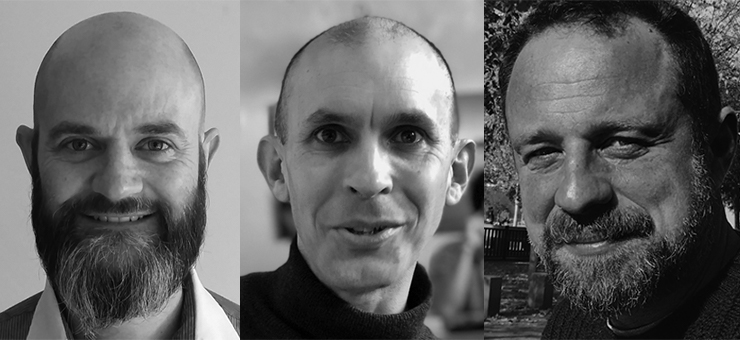By: Jon Farrow
26 Mar, 2020

Recent advances in science and engineering have made possible scenarios where living brain tissue can exist without any sensory connection to the outside world, and CIFAR fellows Tim Bayne, Anil Seth, and Marcello Massimini in the Azrieli Brain, Mind & Consciousness program wonder whether brain tissue that is isolated like this can support consciousness, creating “islands of awareness.”
In a paper published in the January 2020 edition of Trends in Neuroscience, Bayne, Seth, and Massimini consider three cases where these islands of awareness may exist:

Marcello Massimini:
It is difficult to deny their existence in brain-injured patients.
At least in human brains, it is just a matter of logic. We know that people can be blind, deaf, fully paralyzed, and desensitized and still be conscious. We can easily imagine one of these patients, say someone with an extreme form of sensory-motor locked in syndrome, who can still communicate by the faint blink of one eye. Nobody would deny that they are conscious. Now, cut the last axon innervating the eyelid; why should their inner universe suddenly disappear? If you use logic and Occam’s razor, you conclude that islands of awareness must exist!
Anil Seth:
Our ethical stance is often very strongly shaped by context. For example, while we might immediately consider ethics when confronted with human patients with altered consciousness, we may worry less when dealing with ‘cerebral organoids’ which are being developed for technological purposes – primarily to drive medical research. But all technologies have unintended consequences, and we should pay particular attention to these consequences when technologies are fast growing – as is the case for cerebral organoids. Could they be islands of consciousness? Right now, in their current state, it’s unlikely that they have any sort of conscious experience, but the rate of growth of this technology is impressive.
And it would be an ethical catastrophe if we were generating farms of things that turned out to be capable of suffering. There is maybe only a tiny possibility of that being the case, but a tiny possibility of a large catastrophe is something to be taken very seriously.
The kind of ethics that is fit for purpose here is a preemptive ethics. These things need to be considered while they don’t seem all that plausible.
Tim Bayne:
At the December 2018 meeting of the Azrieli program in Brain, Mind & Consciousness, Marcello gave a short talk based on the idea of a post-comatose patient who was conscious but has no capacity for interaction at all.
And then Anil Seth said that he’d been thinking about hemispherotomies, where the connections are severed from one of the brain’s hemispheres, but it’s left in situ. And the fascinating thing was a possibility that there might still be some neural activity in the disconnected hemisphere.
I’d come in from Australia, and the time difference is pretty severe. When I do that flight, I can’t sleep, and the CIFAR meetings are so stimulating. So typically I’m really tired, I get two hours of sleep, and then I wake up at 9pm and can’t get back to sleep until the morning. On this occasion, I just stayed up until 5am writing a paper that engaged with some of the philosophical questions raised by what Marcello and Anil had said, and then I sent an outline draft to them by breakfast.
Marcello Massimini:
In my mind the most general implication is a challenge to functionalist approaches to consciousness. In this view, conscious brains are physical devices that, like computers, perform computations on sensory inputs which produce interesting behaviors.
Demonstrating or recognizing the existence of islands of consciousness that are disconnected from sensory inputs and motor outputs, would shift our attention more on intrinsic brain properties. This has interesting consequences on how we see and assess consciousness in both natural and artificial systems.
Anil Seth:
There are some people who defend what’s been called an externalist view on consciousness, which is that the body and/or the environment don’t just shape conscious experiences, they are constitutively necessary for them. As if the substrate for consciousness isn’t constrained within the skull, but bleeds out into the body in the world. If islands of awareness exist, it puts a lot of pressure on those kinds of theories, because an island of awareness is by definition a case where that does not and cannot happen.
Tim Bayne:
Both of the major theories of consciousness, Global Workspace Theory and Integrated Information Theory, could be developed in a way that is consistent with the existence of islands of awareness. So if these islands exist it’s no silver bullet against those theories. But it’s an incredibly useful data point, and we need all the data points that we can get when trying to develop a theory of consciousness .
The research paper, “Are There Islands of Awareness?,” is available online on the Trends in Neuroscience website.
The CIFAR Azrieli Brain, Mind & Consciousness program, founded in 2014, grapples with the fundamental underpinnings of consciousness, and relates the findings to biology on the one hand and to philosophical questions on the other. By creating the opportunity for deep collaborations across fields and disciplines, the program allows fellows to solve one of the most profound questions about human nature: what are the origins and mechanisms of consciousness? The Azrieli Brain, Mind & Consciousness program is developing a framework to help fellows from across disciplines understand how our brains give rise to consciousness and our unique perspective on the world around us.